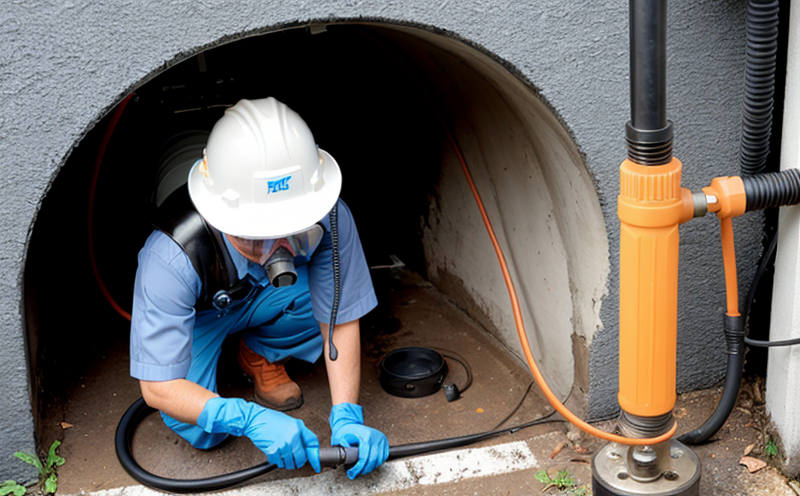Leak detection inspection
In the realm of quality management and compliance, ensuring the integrity of equipment is paramount. A leak can lead to costly downtime, loss of product, environmental hazards, and even safety risks. Leak detection inspections are essential procedures designed to identify potential leaks in various types of equipment used across different sectors.
Leak detection is a critical process that involves the identification of small or large leaks in systems such as pipelines, tanks, containers, and vessels. This service ensures that equipment operates within safe parameters, enhancing reliability and safety. The inspection can be performed on static equipment (non-moving parts) or dynamic equipment (moving parts), depending on the nature of the equipment.
For instance, in the oil and gas sector, leak detection inspections are crucial for preventing contamination and ensuring compliance with regulatory standards such as ISO 15227. In pharmaceutical manufacturing, leaks can lead to product contamination, which is why equipment integrity testing is a key requirement under GMP (Good Manufacturing Practice) guidelines.
The process of leak detection involves several steps: initial visual inspection, pressurization or depressurization if necessary, and then the actual leak detection using various techniques such as soapy water, electronic leak detectors, or specialized gas analysis equipment. The acceptance criteria are based on the equipment's design pressure and operational requirements.
Advanced technologies like helium mass spectrometry can detect extremely small leaks that traditional methods might miss. This is particularly important in sectors where the slightest leakage could have catastrophic consequences. For example, in nuclear facilities, even a minor leak could lead to radioactive contamination, making precise leak detection a non-negotiable requirement.
The importance of leak detection cannot be overstated. It helps maintain equipment integrity and ensures compliance with international standards such as ISO 15227 for oil and gas pipelines or EN 14902 for pressure vessels. By detecting leaks early, potential failures are prevented, extending the service life of the equipment and reducing maintenance costs.
Leak detection inspections also play a critical role in environmental protection. They help minimize the risk of hazardous substances escaping into the environment, which is essential for industries handling chemicals or other potentially harmful materials. Regulatory compliance becomes easier when regular leak detection checks are conducted, ensuring adherence to local and international standards like EN 14902.
The process involves a detailed examination of equipment under various conditions, including pressurization and temperature variations. This ensures that the equipment can withstand operational stresses without compromising its integrity. The use of advanced instrumentation and techniques allows for precise leak detection, even in complex systems where traditional methods may fall short.
Benefits
The benefits of conducting regular leak detection inspections are numerous and far-reaching. First and foremost, it enhances the safety of operations by identifying potential hazards before they escalate into full-blown failures. This proactive approach helps prevent accidents, injuries, and fatalities in work environments where equipment integrity is critical.
Secondly, leak detection inspections contribute to operational efficiency. By ensuring that equipment operates within safe parameters, downtime due to unexpected failures can be significantly reduced. This leads to increased productivity and lower maintenance costs over the long term.
Third, compliance with international standards such as ISO 15227 ensures that operations meet regulatory requirements, thus avoiding potential legal issues and fines. In sectors like pharmaceuticals or nuclear facilities, adherence to these standards is non-negotiable, making leak detection inspections an essential part of the quality management process.
Fourth, environmental protection benefits significantly from regular leak detection checks. By minimizing the risk of hazardous substances escaping into the environment, companies can avoid costly remediation efforts and reputational damage. This aligns with sustainability goals and helps build a positive corporate image.
Fifth, the use of advanced technologies for leak detection allows for more precise identification of leaks, even in complex systems. This leads to better equipment performance and longevity, as potential issues are addressed before they become critical.
Finally, conducting regular leak detection inspections builds trust among stakeholders, including employees, customers, regulators, and environmental groups. It demonstrates a commitment to safety, efficiency, and sustainability, which is crucial in today’s increasingly competitive business environment.
Industry Applications
| Industry Sector | Type of Equipment Inspected | Common Leak Detection Techniques Used | Standards Adhered To |
|---|---|---|---|
| Aerospace | Pipelines and fuel tanks | Solvent-based dye penetrant inspection, helium mass spectrometry | ISO 15227:2019 |
| Pharmaceuticals | Vacuum systems, gas handling equipment | Electronic leak detectors, ultrasonic testing | GMP (Good Manufacturing Practice) |
| Nuclear Energy | Piping and containment structures | Helium mass spectrometry, dye penetrant inspection | EN 14902:2017 |
| Oil & Gas | Pipelines, storage tanks | Solvent-based dye penetrant inspection, electronic leak detectors | ISO 15227:2019 |
| Chemical Processing | Tanks, reactors | Electronic leak detectors, ultrasonic testing | EN 14902:2017 |
Customer Impact and Satisfaction
The impact of regular leak detection inspections extends beyond mere compliance; it significantly enhances customer satisfaction. By ensuring that the equipment operates safely and efficiently, companies demonstrate their commitment to quality and reliability. This not only builds trust with customers but also fosters long-term relationships.
Customers appreciate knowing that they are working with a partner who prioritizes safety and efficiency. This positive perception can translate into increased business opportunities and repeat orders. In sectors like pharmaceuticals or nuclear energy, where the stakes are high, customer satisfaction is directly linked to operational success and regulatory compliance.
The use of advanced leak detection techniques ensures that even the smallest leaks are identified and addressed promptly. This proactive approach not only minimizes downtime but also reduces the risk of costly repairs or replacements down the line. Customers benefit from a more reliable product lifecycle, which ultimately leads to higher customer satisfaction and loyalty.





